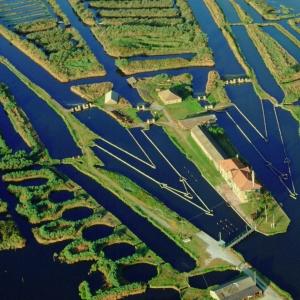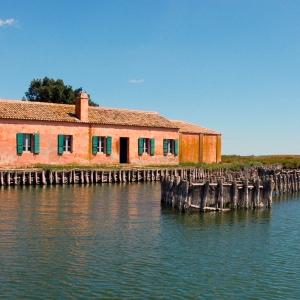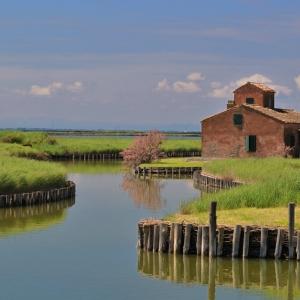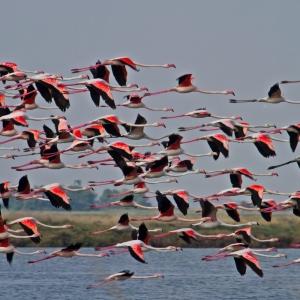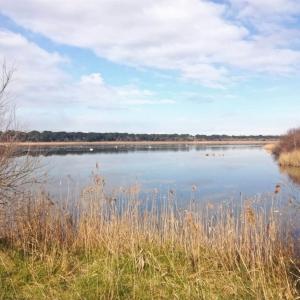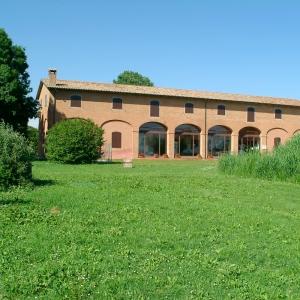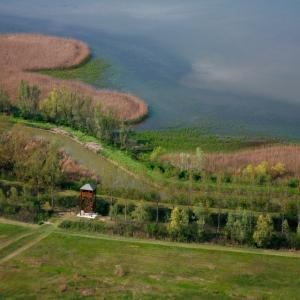THE LAGOONS OF YESTERDAY AND TODAY
The huge expanse of brackish water that once surrounded Comacchio stretched over 66.000 hectares to the municipalities of Argenta, Portomaggiore and Ostellato. The only hope of redemption, in a land that was always considered unproductive and inhospitable, was the "land to cultivate". This collective need leads to the construction of massive hydraulic pumps and to a network of canals to drain millions of cubic meters of water. After the latest reclamation work of the 1960s, some fresh or brackish water basins remain. They represent the original morphology of the territory and are precious treasures to discover and protect. These wetlands retain a great natural value and play an important role in land management.
The Valli di Argenta still serve as overfl ow basins to contain flooding of the Apennine streams that flow into the Reno River. Le Vallette di Ostellato are surrounded by farmland and located near a sandbank of a river now extinct, in an environment completely different from how it was before land reclamation. The Oasis Anse Vallive di Porto - Bacino di Bando is an example of environmental restoration of an area used for
filtering waste water from the nearby sugar mill. The Lagoons of Comacchio, that after reclamation still cover an area of over 11.000 hectares, represent one of the most important stations of the Po Delta Park. There traditions of fishing and fish farming, especially of eel, have developed.
THE CITY OF COMACCHIO
Comacchio nestles between the Adriatic Sea and the fish farms with its quaint town center of canals, bridges and many churches and buildings of great historical and cultural interest. Originally the town was built on thirteen islands, reduced to fi ve after the reclamation, that since the XIXth century, transformed both the city center and the surrounding area. The city experienced its heyday in 1600, when the Church promoted a great restoration of the urban plant. They dug canals to bring "new water" to the city and bridges were built to connect the different neighborhoods. At that time the main gateway to the city was also built: Trepponti, a monumental bridge built by Cardinal Giovan Battista Pallotta in 1634. At the foot of the bridge is the Antica Pescheria (old fish market), a beautiful building of the XVIIth century that illustrates the importance of fishing as the primary economic activity of the city.
Nearby is the Ponte degli Sbirri (Bridge of the Guards), where you can enjoy a splendid view of the neighborhood of San Pietro, on one hand the Ospedale degli Infermi (Hospital of the Sick), and on the other the XIXth century Palazzo Bellini. Near the bridge, inside the old prison, there is the Ancient Delta Museum, where the ancient cargo of a vessel from the Augustan age, discovered in 1981, is on display. Other important buildings are the Loggia del Grano o dei Mercanti, the Torre dell’Orologio (Clock Tower), the Cathedral of San Cassiano, the Church of the Carmine, the Church of the Rosario and the Sanctuary of Santa Maria in Aula Regia which is linked to the town center by the Loggiato dei Cappuccini built in 1647 by Cardinal Stefano Donghi.
THE LAGOONS AND SALTWORKS OF COMACCHIO
The Lagoons of Comacchio, with an area of about 11.000 hectares, represent the most extensive system of brackish wetlands in the region of Emilia Romagna. Crossed by small islands and banks, they are the ideal habitat for many species of birds breeding, wintering and migrating. Also, there remain monuments to the human industry of the past related to fi shing and the extraction of salt. The “casoni” (fisher-huts) scattered in the lagoons were used for fishing eels and other fi sh, while the basins located to the northeast were used to obtain salt. The Saltworks of Comacchio were built in Napoleonic times and once covered an area of more than 600 hectars. In the 1980s, the extraction activities closed down and today the area is one of the most important habitats of the Po Delta. In 2006, thanks to the LIFE project NATURA 2000, the production of salt has been restored for educational and touristic purposes and sustainable access has been promoted.
The peninsula of Boscoforte is the remainder of an ancient sandbar formed in Etruscan times which extends northward for six kilometers from the bank of the Reno river in the southern part of the Comacchiese lagoons. Due to its ecological characteristics, the peninsula attracts a diverse avifauna that is well suited to the simultaneous presence of fresh and brackish water. It is one of the best places for resting and nesting of shelducks, avocets, spoonbills and fl amingos; also here in the wild live several Camargue horses. Boscoforte is considered a paradise for bird watchers and nature photographers.
THE WETLAND OF ARGENTA
The district of the Valli di Argenta includes the Cassa del Bassarone, the Cassa di Campotto, the Bosco del Traversante and the Valle Santa with a total area of 1.624 hectares, representing a habitat of great interest especially in terms of biodiversity. Since 1988, these environments have become part of the station "Campotto di Argenta" of the Po Delta Park. The wetland is a remnant of freshwater marshes in the area: until the XIXth century the Apennine rivers, which were not dammed, spread sediments throughout the area. Only in the early years of the XXth century, with the intervention of man and later a more careful management of water resources, the rivers were redirected into the Reno River. The term "cassa" refers to the function of these basins that lie between the rivers Reno, Idice and Sillaro: in case of need, they serve to contain their high water, in order to protect the reclaimed land.
The Consorzio di Bonifica Renana manages the seasonal changes in water levels. In addition, the presence of a varied vegetation allows these areas to attract numerous bird colonies. The Valle Santa is freely accessible all year round, on foot or by bike; the observation tower provides a beautiful view on the “cassa di espansione” and on the wet meadow.
The Cassa di Campotto can be visited by appointment, accompanied by qualified personnel, on foot, by bicycle, by electric minibus or by boat. The Bosco del Traversante is also equipped with a path for the blinds.
THE WETLAND OF OSTELLATO
The Vallette di Ostellato are remnants of an enormous land reclamation project in the lagoons of Mezzano, ancient and vast marshes colonized since ancient times. From the late XIXth century until the early ‘60s, more than 18.000 hectars were dried and this vast extension presents itself today as a large expanse of cultivated land that serves as a granary for the territory of Ferrara and a rich source of food for the many species of water birds in the various oases of the Delta.
The Vallette are composed of four fresh water wetlands, interspersed with small islands, which have been naturalized; they are: Valle San Camillo, Fossa, Fornace and San Zagno. They extend for approximately 15 kilometers, as a strip of water enclosed between the Canale Navigabile and the Canale Circondariale. The typical vegetation is that of marshy plants and hygrophilous woods; reeds, swamp lilies, water lilies, blackthorn, elder and tamarisk prevail. The Nature Service of the Province of Ferrara set up, in the '70s, an Oasis of Protection of Fauna. It can be accessed through the trails improved with huts, shields and turrets from which you can spot ducks, great herons, great crested grebes, black-winged stilts, passerines, night herons, egrets, squacco herons and white storks. At the Vallette, you can do sportfishing, catch catfish, carp, pike perch, eel and crucian carp. You can also make cycling excursions or observe the stars thanks to the astronomical observatory located in the area, which is also equipped with recreational facilities and accommodations for an overnight stay.
ANSE VALLIVE DI PORTO - BACINO DI BANDO
Located in the municipality of Portomaggiore, the Oasis Anse Vallive di Porto Bacino di Bando is a wetland of great natural value and a resting, wintering and nesting area for many species of birds, including herons, black-winged stilts, marsh harriers, owls and kingfi shers. Surrounded by cultivated fi elds which derive from the reclamation of Mezzano and which are a rich food source for birds, the oasis is a freshwater wetland covering approximately 50 hectares. Thanks to a corridor of land that separates the basins, you can go around the perimeter of the central body of water, either on foot or by bicycle.
Originally the area was a pond in the service of an old sugar mill now inactive and, as often happens to abandoned sites, nature has reclaimed the space facilitating, within the wetlands, the fast colonization by many fl oristic species, able to attract interesting aquatic fauna. So the Province of Ferrara has initiated a series of measures for the protection and environmental restoration of the area, because factors such as the variable depth of the basins (from a few centimeters to a meter) and the rich vegetation attract even rare species. In addition, the oasis is home to two major projects that aim to re-introduce the White Stork and the Greylag Goose, easy to spot thanks to the presence of pathways and observation huts that allow excellent views without creating a disturbance. The Visitor Center, "A Casa della Cicogna", is the organizational center and gateway to the reserve.



